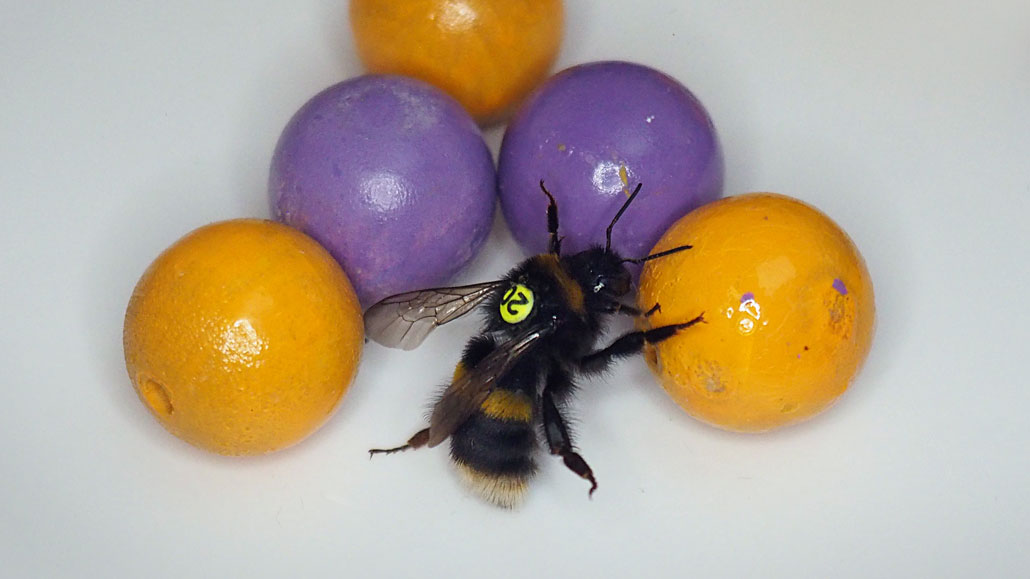Bumblebees go out of their way to play
When given wooden balls, young bees roll them around an arena

Bees in a new study could choose from different colored balls that mimicked flower colors they might visit in the wild.
Richard Rickitt
Share this:
- Share via email (Opens in new window) Email
- Click to share on Facebook (Opens in new window) Facebook
- Click to share on X (Opens in new window) X
- Click to share on Pinterest (Opens in new window) Pinterest
- Click to share on Reddit (Opens in new window) Reddit
- Share to Google Classroom (Opens in new window) Google Classroom
- Click to print (Opens in new window) Print
When you’re bored, you might start playing with a ball or other object. Such behavior is common in people. Other animals like it too — that’s why a dog fetches a stick, or a cat bats at toys. Play is an enjoyable way to pass the time. A new study finds that it’s not just mammals that like to play. Bumblebees do it too.
That finding appeared in the December issue of Animal Behaviour.
Researchers consider play to be a sign of intelligence. They mainly study it in vertebrates — animals with backbones. These studies find that young animals spend much of their time playing. As they get older, they do it less. Unlike other types of behavior, play doesn’t lead to a reward. It doesn’t get an animal food, a mate or shelter. Yet they still do it.
We know that play is fun for people — the act of playing is the reward. It’s likely the same for other kinds of animals.
Hiruni Samadi Galpayage Dona wanted to know if bumblebees might play. She is a graduate student at Queen Mary University of London in England. “Something that is crucial for bees is to learn to manipulate flowers to get their food,” she says. Interacting with objects could help bees learn skills for when they are older. But in order to know whether play helps young bees build skills, Galpayage Dona first needed to see if they played with objects when given the chance.
Play ball
Galpayage Dona’s experimental setup consisted of a box, a tunnel and a flight arena. The small box contained a nest with about 200 bees. Of those, 45 had been tagged with a number when they emerged as adults, so the researchers knew how old they were. The nest connected to a flight arena — a larger box — via a tunnel. The arena provided plenty of pollen and sugar water, so the bees had enough to eat.
The bees could walk through a clear path in the tunnel to reach food. Or they could choose to explore areas on either side of the path. One side contained small wooden balls that rolled. The other side had the same number of balls, but they were stuck to the floor. One-third of the balls on each side were painted yellow and one-third purple. The rest were left unpainted. Galpayage Dona used different colors “to see whether bees would show a preference for a given color.” They often do prefer certain colors of flowers, she notes.
For three hours a day over 18 days, Galpayage Dona gave the bees free access to the flight arena via the tunnel. She found that bees often explored the side areas and interacted with the balls. But once they managed to roll a ball, they strongly preferred that side. They returned, climbing on the balls and rolling them around.
“There’s something about the mobility that is more interesting for the bees than just colored objects,” Galpayage Dona says. In another experiment, she sometimes left the balls out overnight. “When I came in the next day, I would always find some bees rolling the balls.” As with mammals, the bees who played the most were the younger ones. Their play tapered off as they got older.
To determine whether the bees found ball play rewarding, Galpayage Dona set up another experiment. In this one, bees could access two chambers. One was painted yellow, the other blue. One chamber contained movable balls, the other was empty. Some bees found balls in the yellow chamber, others in the blue chamber. The researcher then removed all balls and let the bees choose between the two chambers.
Overall, bees preferred yellow to blue. But bees that had played with balls in the blue chamber were more likely to choose it over the yellow one.
This “tells us that bees might experience something like fun,” Galpayage Dona says. “Nobody had looked at whether behavior in itself — the action — can be rewarding in bees.” But bees’ preference for areas where they rolled balls suggests that it is.
As for whether play helps them become better foragers, that experiment is currently underway.
“I hope that people see from [this study] that bumblebees are not robot-like alien creatures,” says Elaine Evans. She is a bumblebee researcher at the University of Minnesota in St. Paul who was not involved with the study. “Young bumblebees can do complicated and sophisticated tasks that could help their brains develop,” she notes. It’s easy to compare the bees’ observed behaviors to play in mammals. But, she cautions, it “could be something very different in the world of the bumblebees — something we may not even have a word for.”
Galpayage Dona hopes the new findings will show people that bees are not so different from us. “Traditionally we’ve viewed bees as workaholics,” Galpayage Dona says. People “think the whole point of bees is that they’re pollinators and we need them to survive.” But this study suggests bees are capable of much more than people have realized. “They may experience something like pleasure,” she notes. “Even if they’re small creatures with small brains, they deserve just as much respect as the bigger, fluffier, more charismatic animals, like our pets.”







